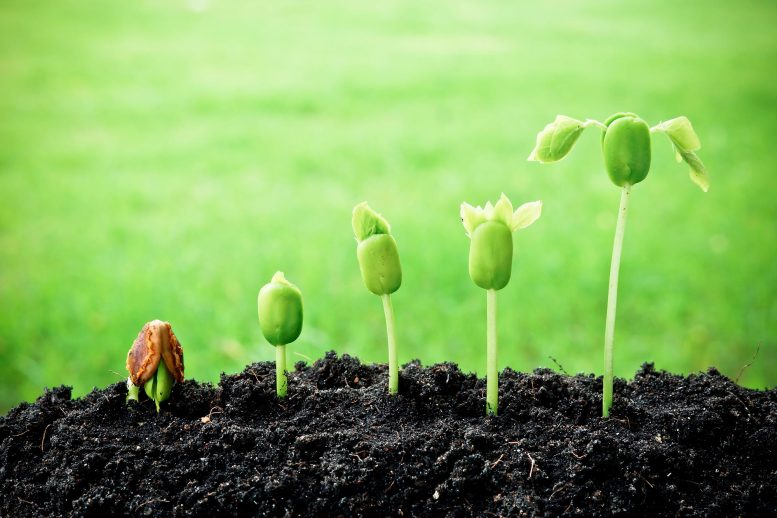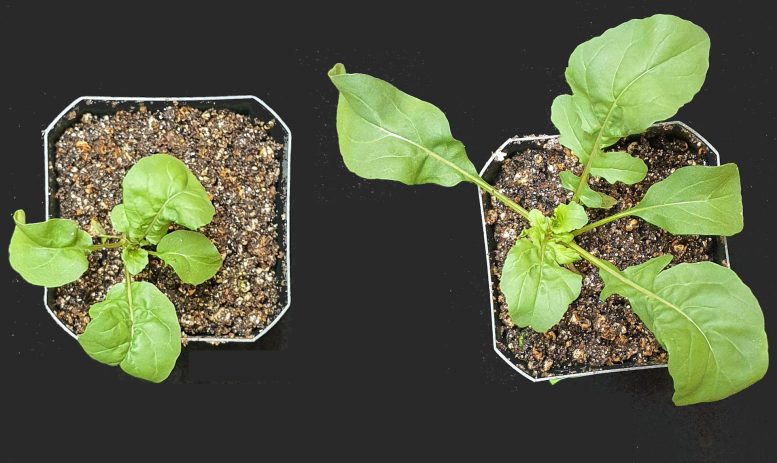
‘Priming’ plants by exposing them to certain chemicals while they’re seeds can affect their growth later in life.
Researchers have found that treating seeds with ethylene gas increases both their growth and stress tolerance. This discovery, involving enhanced photosynthesis and carbohydrate production in plants, offers a potential breakthrough in improving crop yields and resilience against environmental stressors.
Just like any other organism, plants can get stressed. Usually, it’s conditions like heat and drought that lead to this stress, and when they’re stressed, plants might not grow as large or produce as much. This can be a problem for farmers, so many scientists have tried genetically modifying plants to be more resilient.
However plants modified for higher crop yields tend to have a lower stress tolerance because they put more energy into growth than into protection against stresses. Similarly, improving the ability of plants to survive stress often results in plants that produce less because they put more energy into protection than into growth. This conundrum makes it difficult to improve crop production.
I have been studying how the plant hormone ethylene regulates growth and stress responses in plants. In a study published in July 2023, my lab made an unexpected and exciting observation. We found that when seeds are germinating in darkness, as they usually are underground, adding ethylene can increase both their growth and stress tolerance.
Ethylene Is a Plant Hormone
Plants can’t move around, so they can’t avoid stressful environmental conditions like heat and drought. They take in a variety of signals from their environment such as light and temperature that shape how they grow, develop, and deal with stressful conditions. As part of this regulation, plants make various hormones that are part of a regulatory network that allows them to adapt to environmental conditions.
Ethylene was first discovered as a gaseous plant hormone over 100 years ago. Since then, research has shown that all land plants that have been studied make ethylene. In addition to controlling growth and responding to stress, it is also involved in other processes such as causing leaves to change color in the fall and stimulating fruit ripening.
Ethylene as a Way To ‘Prime’ Plants
My lab focuses on how plants and bacteria sense ethylene and on how it interacts with other hormone pathways to regulate plant development. While conducting this research, my group made an accidental discovery.
We’d been running an experiment where we had seeds germinating in a dark room. Seed germination is a critical period in a plant’s life when, under favorable conditions, the seed will transition from being dormant into a seedling.
For this experiment, we exposed the seeds to ethylene gas for several days to see what effect this might have. We’d then removed the ethylene. Normally, this is where the experiment would have ended. However, after gathering data on these seedlings, we transferred them to a light cart. This is not something we usually do, but we wanted to grow the plants to adulthood so we could get seeds for future experiments.
Several days after placing the seedlings under light, some lab members made the unexpected and startling observation that the plants briefly gassed with ethylene were much larger. They had larger leaves as well as longer and more complex root systems than plants that had not been exposed to ethylene. These plants continued growing at a faster rate throughout their whole lifetime.

The plant on the left was not primed with ethylene, while the plant on the right was. Both plants are the same age. Credit: Binder lab, University of Tennessee, Knoxville
My colleagues and I wanted to know if diverse plant species showed growth stimulation when exposed to ethylene during seed germination. We found that the answer is yes. We tested the effects of short-term ethylene treatment on germinating tomato, cucumber, wheat and arugula seeds – all grew bigger.
But what made this observation unusual and exciting is that the brief ethylene treatment also increased tolerance to various stresses such as salt stress, high temperature and low oxygen conditions.
Long-term effects on growth and stress tolerance from brief exposure to a stimulus are often called priming effects. You can think of this much like priming a pump, where the priming helps get the pump started easier and sooner. Studies have looked at how plants grow after priming at various ages and stages of development. But seed priming with various chemicals and stresses has probably been the most studied because it is easy to carry out, and, if successful, it can be used by farmers.
How Does It Work?
Since that first experiment, my lab group has tried to figure out what mechanisms allow for these ethylene-exposed plants to grow larger and tolerate more stress. We’ve found a few potential explanations.
One is that ethylene priming increases photosynthesis, the process plants use to make sugars from light. Part of photosynthesis includes what is called carbon fixation, where plants take CO₂ from the atmosphere and use the CO₂ molecules as the building blocks to make the sugars.
During photosynthesis and carbon fixation, plants take in sunlight and convert it into the sugars that they use to grow.
My lab group showed that there is a large increase in carbon fixation – which means the plants are taking in much more CO₂ from the atmosphere.
Correlating with the increase in photosynthesis is a large increase in carbohydrate levels throughout the plant. This includes large increases in starch, which is the energy storage molecule in plants, and two sugars, sucrose and glucose, that provide quick energy for the plants.
More of these molecules in the plant has been linked to both increased growth and a better ability for plants to withstand stressful conditions.
Our study shows that environmental conditions during germination can have profound and long-lasting effects on plants that could increase both their size and their stress tolerance at the same time. Understanding the mechanisms for this is more important than ever and could help improve crop production to feed the world’s population.
Written by Brad Binder, Professor of Biochemistry & Cellular and Molecular Biology, University of Tennessee.
Adapted from an article originally published in The Conversation.![]()









Interesting, but the article gives no idea of how to “prime” the seeds or young plants. This is of no practical use to us growers, just academic trumpet blowing. How about some real world advice including where to get some ethylene and how to use it.
Most ripening fruits give of ethylene gas, that’s why we can put green tomatoes inside a paper bag to concentrate the gas and facilitate the process.
Enclose your seed trays with some odd fruits, not rocket science, adjust your materials and methods to suit your circumstances and creative imagination.
Google: ethylene fruit ffi.
That’s exactly what I was thinking. Good timing as I’m preparing to get my seeds started.
Lol. Amazing how your politics inform your worldview and hinder your ability to navigate the world. Almost every single thing you use in your life you can thank science for either discovering, improving or understanding. Blaming the “academics” for your lacking the ability to find and overcome the obstacles in front of you isnt fair. But who can resist an opportunity to use catch phrases and buzzwords they learn on podcasts and YouTube videos, right? Figure it out. You have an internet connection,use it for something other than porn. Show some gratitude for academics as you use a computer whose invention is credited to a gay atheist Academic.
Whatever dysfunction you are complaining about, you appear to possess to a much greater degree.
Amen!
I think you could incubate seeds in a baggie with cut up ripe apples for, say, 48 hours, then plant them. Everyone knows they emit ethylene gas to the extent you can ripen other fruit by that method.
This article was a bit intriguing for me, as a perfume and fine fragrance enthusiast, as well as a (sometimes) fragrance ingredients purchaser, for manufacturing fragrances, at the retail consumer level, having purchased and investigated the ingredient ethylene brassylate. I’d known about ethylene gas, prior to becoming a perfumer – I somewhat recall “ethylene,” previously, in life, having been named with two words, or something like that – I guess that my marketing segment demographic placement perhaps lopped off the second identifier, in favor of a common root word, which pertains to chemistry, in general – fragrance and aroma chemicals are where I find practical understanding of chemistry more applicable and accessible, being that I’m not all that strongly suited for sciences studies, at the level of schooling that I’d attended, in life.
Anyways, I’d purchased a small portion of ethylene brassylate, as a fragrance ingredients “component,” (potentially), of a fragrance composition. It’s described, in fragrance terms, in a few different manners, such as ambrette and musky, although the sample that I’d purchased seemed to not have much of a smell, to it, that I could recall, or pick out, at the time I had it. I figure that perhaps ethylene brassylate could potentially be used in fragrance making, to suit some sort of lifestyle casual correlation, with growing plants, for example, as your article might allude to, suggestibly.
It would have been helpful to have the chemical formulas for some of the described biological processes and components of the ethylene bio-checmical workflow, such as sugar and starch, just to have that sort of thing at hand, for the layperson; that’s just my observation. Thanks for writing this article. It popped up at the top of my day’s Google Chrome tab news and article feed.
So how do I get ethylene to the seedlings? Water them with cider? This sounds like a gamechanger.
Most ripening fruits give of ethylene gas, that’s why we can put green tomatoes inside a paper bag to concentrate the gas and facilitate the process.
Enclose your seed trays with some odd fruits, not rocket science, adjust your materials and methods to suit your circumstances and creative imagination.
https://less-saves-the-planet.com/ethylene-gas-that-rots-fruits/?lang=en
ffi. Google: ethylene gas fruit
Short answer banana in bag with seeds.
🙂
What amount of ethylene?
Does quality compost provide enough?
Leave your fruits and veggies in the plastic bags they’re sold in and you will have no shortage of ethylene gas and eventually compost.
Is this discovery of planting seeds with ethylene real new?
Its used on youtube on growing plants. It’s only the name of the gas which is unknown.
It’s a good reasearch case study, producing the idea for new experiments and generation of new results for the validation and acceptance
Keifer and his Africans are in Baltimore city now to be aware killing fo jay rohrer iv so Judy Carney melo, brown eyes has explained. Is she telling the truth or playingg Orson Wells again?
So what triggers ethylene production naturally? Under what conditions would seeds normally be exposed to ethylene in the wild? It would be interesting to see when and why such an apparently beneficial effect occurs without human intervention. Food for thought.
I think we are taking the wrong approach to water conservation. We are charging farms more for water causing them to drill and tap into groundwater in California and our water table keeps getting lower every year. Snow pack does not recharge groundwater when it is piped to LA rain alone is not enough to recharge groundwater supplies and an attempts to cut costs. Farms are using drip irrigation rather than flood irrigation which recharged groundwater supplies. Drip only supplies the plant with enough to stay alive. Nothing is left for groundwater so of course naturally the groundwater is going to continue to dry up but it seems no one is looking at this obvious answer to the problem
They need to figure out how to give a wiff to three hundred acres of corn when it turns hot and no rain. I need some for my yard by the way.
This begs so many more questions.
My main one being, will this result in better stress protection for those consuming the plants as well?
I will certainly be testing some of my own seeds.
https://bmcbiol.biomedcentral.com/articles/10.1186/s12915-016-0230-0
Very interesting and informative article
Am I missing something here?, this article is from 2016 and it exposed all what is mentioned here
https://bmcbiol.biomedcentral.com/articles/10.1186/s12915-016-0230-0
old news re hashed
the benefits of ethylene have been written about for years…..
Hey KEITH 👋🏼 what REALLY WINDS ME UP to GRINDS MY GEARS is the FACT THEY KNOW THE SOLUTION ON HOW TO FIX EVERYTHING THATS NEED FIXING.
We can be that SQUEAKY WHEEL unfortunately we’ll NEVER GET the GREASE. …
Very Interesting,Would Like To Know More. Thank You
Has no one spoken about the taste of this gas in the food and the side effects on humans who consume such food and vegetables? I recently purchased some ripe plantains however I was not able to eat them because after cooking them they tasted like gasoline and smelled like it. Same for some mangos I purchased over the summer. So my understanding of this article we are giving up health over the size and beauty of the produce to be sold. Also the rate and which you can sell them. Not all all thinking about the health and concerns about humankind. Our children and parents will eat these fruits and vegetables and then will end up with the side effects of injecting a firm of gasoline.
You’re thinking of ethanol. It’s naturally produced by every plant. Fruits wouldn’t ripen without it. So yeah, you’ve completely misunderstood.
*(“ethyline is naturally produced…”)
Thanks to all the commenters (excepting one) for their posts. Interesting stuff. I will be trying this out, and encouraging more development. A world without Roundup…. I wish!
I have read all comments I could find. Seems simple and elegant. We all can find out that planting a seed in a slice of banana buried in soil can greatly enhance germination/growth. Bananas ripen other fruits with ethylene production and the skins provide potassium and calcium. Fetilizer coated seeds are well known. So the local and global solutions are obvious. Blender with Miracle-Gro, banana(skin on), blended, pour into little square ice cube trays, put upright toothpick in center of tiny cube, dessicate in freezer over the winter, or pop into your vacuum dehydrator, and when it comes time to plant, pull the toothpick out of the little cube, put your seed in the little or big hole in the cube, plant, and water!!! The commercial solution to this is equally obvious and elegant!! 👌 Farmers, where are you?? Here is your practical gift of the day!!!
Good science!!! However, ethylene gas is not a friend to the environment. Therefore, application in the field and toxicity needs scientfic investigation before the uninformed overwhelm social media with junk.
Does Ethephon have same effect?
7im not a chemist I’ve always put seed in banana to germinate in dark bag I would remove banana from germinate seed plant banana first about 2″ cover with dirt then plant terminated seed on top of banana water and let her grow
Ethyline gas improves CO2 consumption, solves one problem;
It also conducts hallucinations and other mind/conscious altering euphoric sensations in humans. Could that lead to a reduction of political calamity such as war? Pump up ethyline gas in my neighborhood, eh?